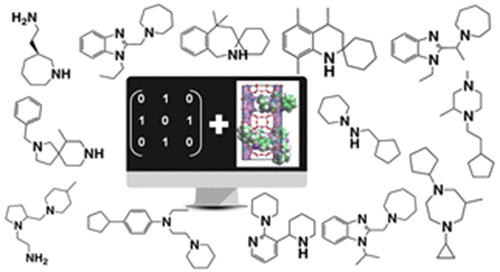当前位置:
X-MOL 学术
›
J. Chem. Inf. Model.
›
论文详情
Our official English website, www.x-mol.net, welcomes your feedback! (Note: you will need to create a separate account there.)
Identification of New Templates for the Synthesis of BEA, BEC, and ISV Zeolites Using Molecular Topology and Monte Carlo Techniques.
Journal of Chemical Information and Modeling ( IF 5.6 ) Pub Date : 2020-05-27 , DOI: 10.1021/acs.jcim.0c00231 María Gálvez-Llompart 1, 2 , Jorge Gálvez 2 , Fernando Rey 1 , German Sastre 1
Journal of Chemical Information and Modeling ( IF 5.6 ) Pub Date : 2020-05-27 , DOI: 10.1021/acs.jcim.0c00231 María Gálvez-Llompart 1, 2 , Jorge Gálvez 2 , Fernando Rey 1 , German Sastre 1
Affiliation

|
The presence of organic structure directing agents (templates) in the synthesis of zeolites allows the synthesis to be directed, in many cases, toward structures in which there is a large stabilization between the template and the zeolite micropore due to dispersion interactions. Although other factors are also important (temperature, pH, Si/Al ratio, etc.), systems with strong zeolite–template interactions are good candidates for an application of new computational algorithms, for instance those based in molecular topology (MT), that can be used in combination with large databases of organic molecules. Computational design of new templates allows the synthesis of existing and new zeolites to be expanded and refined. Three zeolites with similar 3-D large pore systems, BEA, BEC, and ISV, were selected with the aim of finding new templates for their selective syntheses. Using a training set of active and inactive templates (obtained from the literature) for the synthesis of target zeolites, it was possible to select chemical descriptors related to activity, meaning a good candidate template. With a discriminant function defined upon MT, the screening through a database of organic molecules led to a small subset (preselection) of candidate templates for the synthesis of BEA, BEC, and ISV. As far as we know, this is the first time that topological/topochemical descriptors, which do not consider 3-D information on the molecules, have been used to predict the activity of zeolite structure directing agents (SDAs). Following the prediction of SDAs using MT, an automated approach of sequential template filling of micropores based on a combination of Monte Carlo and lattice energy minimization was applied for all the candidate templates in the three zeolites. Two results can be obtained from this: an evaluation of the quality of the molecular topology QSAR models leading to the preselection of templates, and a final selection of candidate templates for the selective synthesis of BEA, BEC, and ISV. Regarding the latter, a good template will be that which maximizes the zeolite–template dispersion interactions with one, and only one, of the three zeolites. The presented methodology can be used to find alternative (maybe cheaper or perhaps more selective) templates than those already known.
中文翻译:

使用分子拓扑和蒙特卡洛技术鉴定合成BEA,BEC和ISV沸石的新模板。
在沸石的合成中有机结构导向剂(模板)的存在使得在许多情况下,该合成被引导向其中由于分散相互作用而模板和沸石微孔之间具有较大稳定性的结构。尽管其他因素(温度,pH值,Si / Al比等)也很重要,但是具有强大的沸石-模板相互作用的系统是应用新计算算法(例如基于分子拓扑(MT)的算法)的良好候选者。可与大型有机分子数据库结合使用。新模板的计算设计使现有和新沸石的合成得以扩展和完善。具有类似3-D大孔隙系统的三种沸石,BEA,BEC和ISV,选择它们的目的是寻找用于其选择性合成的新模板。使用用于合成目标沸石的活性模板和非活性模板的训练集(从文献中获得),可以选择与活性相关的化学描述符,这意味着一个好的候选模板。借助MT定义的判别功能,通过有机分子数据库进行的筛选导致可合成BEAE,BEC和ISV的候选模板的一小部分(预选)。据我们所知,这是第一次没有使用分子的3-D信息的拓扑/拓扑化学描述符来预测沸石结构导向剂(SDA)的活性。在使用MT预测SDA之后,一种基于蒙特卡洛和晶格能量最小化的微孔顺序模板填充自动方法被应用于三种沸石中的所有候选模板。从中可以得到两个结果:对分子拓扑QSAR模型的质量进行评估,从而导致模板的预选;以及对BEA,BEC和ISV进行选择性合成的候选模板的最终选择。关于后者,一个好的模板将是最大化与三种沸石中的一种(只有一种)的沸石-模板分散相互作用的模板。所提供的方法可用于查找比已知模板更可替代的模板(可能更便宜或更具有选择性)。
更新日期:2020-06-23
中文翻译:

使用分子拓扑和蒙特卡洛技术鉴定合成BEA,BEC和ISV沸石的新模板。
在沸石的合成中有机结构导向剂(模板)的存在使得在许多情况下,该合成被引导向其中由于分散相互作用而模板和沸石微孔之间具有较大稳定性的结构。尽管其他因素(温度,pH值,Si / Al比等)也很重要,但是具有强大的沸石-模板相互作用的系统是应用新计算算法(例如基于分子拓扑(MT)的算法)的良好候选者。可与大型有机分子数据库结合使用。新模板的计算设计使现有和新沸石的合成得以扩展和完善。具有类似3-D大孔隙系统的三种沸石,BEA,BEC和ISV,选择它们的目的是寻找用于其选择性合成的新模板。使用用于合成目标沸石的活性模板和非活性模板的训练集(从文献中获得),可以选择与活性相关的化学描述符,这意味着一个好的候选模板。借助MT定义的判别功能,通过有机分子数据库进行的筛选导致可合成BEAE,BEC和ISV的候选模板的一小部分(预选)。据我们所知,这是第一次没有使用分子的3-D信息的拓扑/拓扑化学描述符来预测沸石结构导向剂(SDA)的活性。在使用MT预测SDA之后,一种基于蒙特卡洛和晶格能量最小化的微孔顺序模板填充自动方法被应用于三种沸石中的所有候选模板。从中可以得到两个结果:对分子拓扑QSAR模型的质量进行评估,从而导致模板的预选;以及对BEA,BEC和ISV进行选择性合成的候选模板的最终选择。关于后者,一个好的模板将是最大化与三种沸石中的一种(只有一种)的沸石-模板分散相互作用的模板。所提供的方法可用于查找比已知模板更可替代的模板(可能更便宜或更具有选择性)。


























 京公网安备 11010802027423号
京公网安备 11010802027423号